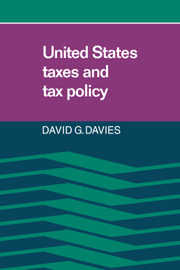Book contents
- Frontmatter
- Contents
- Preface
- 1 Economic foundations of U.S. tax policy
- 2 The individual income tax
- 3 Economic effects of individual income taxes and inflation
- 4 Expenditure versus income taxation
- 5 The taxation of capital gains
- 6 The corporation income tax
- 7 The corporation income tax and inflation
- 8 Social security payroll taxes
- 9 The value added tax
- 10 The sales tax
- 11 State taxes
- 12 Local government taxes
- 13 The distribution of tax burdens
- 14 Status of U.S. taxes and policy
- Appendix
- References
- Index
14 - Status of U.S. taxes and policy
Published online by Cambridge University Press: 05 May 2010
- Frontmatter
- Contents
- Preface
- 1 Economic foundations of U.S. tax policy
- 2 The individual income tax
- 3 Economic effects of individual income taxes and inflation
- 4 Expenditure versus income taxation
- 5 The taxation of capital gains
- 6 The corporation income tax
- 7 The corporation income tax and inflation
- 8 Social security payroll taxes
- 9 The value added tax
- 10 The sales tax
- 11 State taxes
- 12 Local government taxes
- 13 The distribution of tax burdens
- 14 Status of U.S. taxes and policy
- Appendix
- References
- Index
Summary
How do U.S. taxes and policy stack up against the various criteria for a sound and effective tax system enumerated in Chapter 1? The answer is not encouraging.
By the mid-1980s, the chorus of critics of the tax structure had grown enormously. As Pechman (1982:145) notes, there is an almost universal demand for tax revisions and tax reduction. The reason for this state of affairs is the intense and near universal dissatisfaction with the way taxes actually work in practice. They fail to a significant degree to meet the principles of a good tax. Chapters 1, 2, 3, 5, 6, 7, and 8 chronical a long list of important and critical defects in the federal tax structure.
Despite the recent legislation authorizing the indexing of the individual income tax, the tax system as a whole has not been able to cope effectively with the capricious and counterproductive effects of inflation. Moreover, there is danger that this partial indexing of the system will be repealed by a Congress deeply concerned over unprecedentedly high and continuing budget deficits.
Other serious defects embedded in the tax structure include the existence of a socially unproductive tax shelter industry; the extreme complexity of the system with the concurrent growth of the tax preparation and avoidance industry; the inequitable and inefficient marriage, payroll, capital gains, and individual and corporate income taxes; and the high cost of administering these levies.
- Type
- Chapter
- Information
- United States Taxes and Tax Policy , pp. 285 - 287Publisher: Cambridge University PressPrint publication year: 1986



